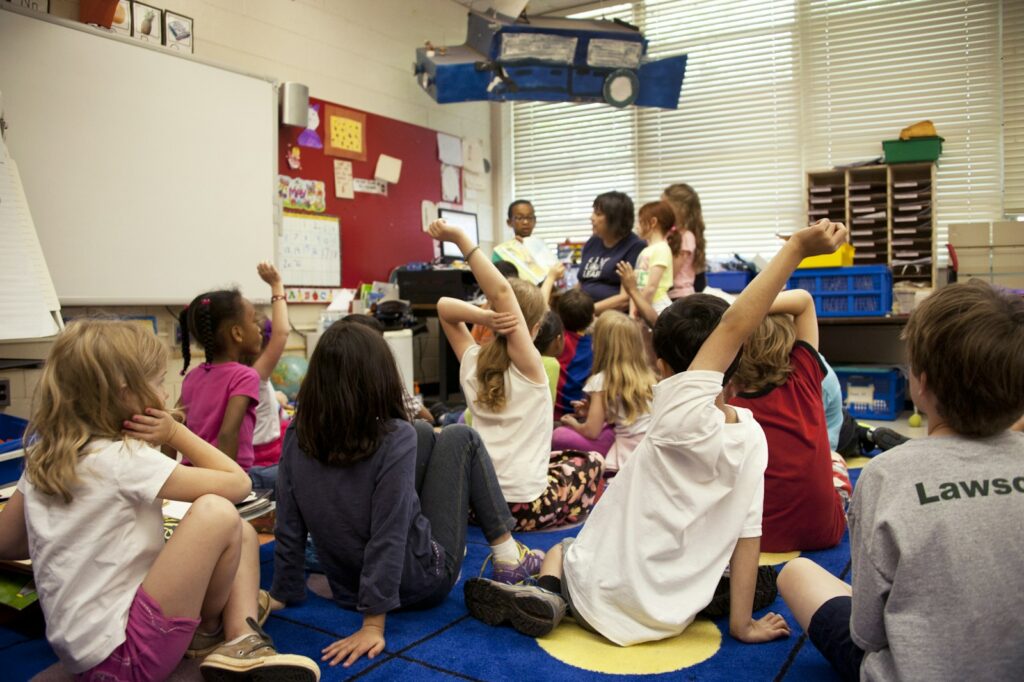Effective Classroom Management To Teach In The New Year
1. Setting the Stage for a Successful School Year
As a school administrator, I’ve learned firsthand how essential it is to kick off the school year—or return after a long break—with solid classroom management strategies on the first day of school. Effective classroom management directly impacts student learning, engagement, and the success of your instructional time. Whether you’re a new teacher or a veteran teacher, having clear and consistent strategies ensures a positive learning environment where all students can thrive. Especially after major breaks like summer or the holidays, giving your students time to reconnect and adjust before diving back into the books is important.
To help ease your students back into the learning process, try incorporating some structured activities that allow them to chat about their break experiences. Here are two strategies that have worked well for both elementary and secondary classrooms:
Example 1: Think-Pair-Share Strategy
This method encourages students to reflect individually and then share their thoughts with a peer in a structured manner. It’s a great way to engage them while maintaining order.
-
Step 1: Present a discussion question related to the break or another topic. This can be done orally or written on the board.
-
Step 2: Allow students a moment of wait time to think about their responses individually.
-
Step 3: Instruct students to pair up with a partner—either assigned or of their choosing.
-
Step 4: Have students share their answers with their partners, taking turns to speak and listen.
-
Step 5: Call on volunteers or select students to share their thoughts with the whole class after the pair discussions.
Tips for Success:
-
Set clear rules for talk time to ensure the activity stays on track.
-
Keep the time for each step structured to prevent lingering conversations.
-
Remind students to limit their movement and remain seated during the activity.
Example 2: Group Discussion by Number
This method allows for more dynamic movement and interaction while maintaining a controlled environment. Grouping by number ensures variety in conversation while allowing students to express themselves.
-
Step 1: Count off the students by fours or fives, depending on your class size. Each student will be assigned a number (e.g., 1, 2, 3, 4).
-
Step 2: Instruct students to group together by their assigned numbers (e.g., all the “1s” gather in one group, all the “2s” in another, etc.).
-
Step 3: Provide the groups with a topic related to their break, or allow them to engage in a brief free talk session.
-
Step 4: Set a timer to manage the length of the discussion, ensuring that all groups stay on task.
-
Step 5: After the time is up, bring the class back together and either call on a group spokesperson to summarize or transition into the next activity.
Tips for Success:
-
Keep students accountable by assigning each group a spokesperson or note-taker.
-
Establish clear classroom expectations for movement and noise levels.
-
Allow some flexibility for students to express themselves, but be ready to redirect any off-topic conversations.
By allowing students this structured time to share their break, you acknowledge the importance of a mental reset while ensuring a smooth transition back to academic work. Whether using think-pair-share or a group discussion by number, both methods provide students with an opportunity to connect, setting the foundation for a successful school year.
2. Student Learning & Engagement: The Heart of Your Classroom

At the core of effective teaching is student learning and engagement. Without these two elements, even the best lesson plans will fall flat. As a teacher, it’s essential to create activities that capture students’ attention and help them dive deeper into the material. Engage students with hands-on tasks, group work, and class discussions to spark their interest. For instance, using a variety of learning activities like debates, role-playing, or projects can help maintain high levels of student engagement throughout the class period. The more engaged your students are, the fewer behavior problems you’ll encounter, leading to smoother instructional time. A positive learning environment naturally follows when students actively participate in their learning journey.
Example: Starting Small with Engagement and Structure
-
Week 1: Begin with engaging instructional activities, but limit movement and open discussions. Focus on tasks that encourage student thinking and problem-solving, like independent reflection, written responses, or digital tools for collaboration.
-
Establish Structure: Reinforce classroom procedures during this time. Ensure students follow transitions, behavior, and participation rules before introducing more group-based work.
-
Gradually Add Movement: Once students consistently show they remember the routines, reintroduce activities requiring movement or group discussion.
-
Monitor and Adjust: Continue to increase the level of freedom as students demonstrate responsibility and understanding of expectations. This step-by-step approach ensures that the class remains engaged without sacrificing structure.
This method allows for meaningful, focused learning while helping students transition into the classroom rhythm.
3. Understanding the Importance of Classroom Management
Classroom management is the foundation for a productive and successful school year. Without it, even the best teaching methods can fall apart, leading to disruptive behavior, loss of instruction time, and a poorly managed classroom. On the other hand, teachers who implement effective classroom management strategies can foster a positive learning environment where students are engaged, respectful, and ready to learn. The difference between a well-managed classroom and one that struggles with discipline issues often reflects the teacher’s ability to maintain order and provide structure.
Effective Classroom Management
Effective classroom management strategies involve more than just setting rules; they focus on building relationships, creating a consistent structure, and ensuring that expectations are clear from day one. These strategies allow teachers to minimize disruptions and maximize instructional time. Whether a new teacher or a seasoned professional, understanding how to keep students engaged while maintaining order is crucial to creating a space where learning thrives. Veteran teachers often rely on routines, consistent consequences, and positive reinforcement to ensure smooth transitions and minimize disruptions.
Why it Matters
When classroom expectations and rules aren’t clearly established, it opens the door for inappropriate behavior and discipline problems. This leads to constant interruptions that take away precious learning moments, making maintaining an orderly learning environment harder. The lack of structure can result in a poorly managed classroom, where students are confused about what’s expected, and teachers are constantly putting out fires rather than teaching.
Example: Poor vs. Effective Classroom Management
|
Situation |
Poor Classroom Management |
Effective Classroom Management |
|
Scenario: Students enter the classroom after lunch. Several are talking loudly, and one student refuses to sit in their seat, causing a disruption. |
The teacher raises their voice and tells students to “be quiet” without a clear follow-up, leading to more confusion. Other students start whispering and wandering, further derailing the class period. The teacher spends most of the time getting students to focus, significantly losing instructional time. |
The teacher greets students at the door with clear instructions for the next activity. Students know what is expected because the teacher has initially reinforced classroom expectations. The teacher calmly redirects the student, refusing to sit, using non-verbal cues or offering a choice. This consistent approach minimizes the disruption, and the class quickly gets back on track, maintaining a productive learning environment. |
|
Situation |
Poor Classroom Management |
Effective Classroom Management |
|
Scenario: A student is refusing to do any work during an individual assignment. |
Sitting at their desk, the teacher notices the student off-task and calls out from across the room, “Why aren’t you doing your work?” This draws attention to the student, disrupting the entire class and making the student defensive. The classroom noise increases, and instructional time is lost as the teacher spends time trying to get the class back on track. |
The teacher, already circulating the room, walks near the student’s desk. Without calling attention to the situation, the teacher quietly asks if the student needs help or clarification, maintaining a calm tone. This personal approach keeps the learning environment positive, allowing the student to get back on task without disrupting others. The class remains focused and continues working efficiently. |
|
Situation |
Poor Classroom Management |
Effective Classroom Management |
|
Scenario: One student begins talking |
From a distance, the teacher loudly calls out to the talking student to stop. This sudden interruption causes other students to look up, lose focus, and engage in side conversations. The noise level increases and the overall learning environment is disrupted. Instruction time is lost as the teacher struggles to regain control. |
The teacher walks around the room, quietly approaching the students and reminding them to refocus. By asking if they need help, the teacher avoids drawing unwanted attention to the situation. The class remains engaged, and the lesson continues smoothly. These best practices enhance effective instruction. |
|
Impact on the class |
The interruption causes multiple students to lose focus, with side chatter spreading, making it difficult for the class to return to a quiet working state. |
The subtle reminder allows the class to remain on task without any major disruption, ensuring that instruction time is preserved. |
In all situations, effective classroom management minimizes distractions, helps maintain a positive learning environment, and handles disruptions quickly and smoothly, maximizing instructional time. Proactive, calm strategies keep students engaged and focused on their work. A well-managed classroom versus poor classroom management directly affects student work.
4. Building Positive Relationships with Students
Building positive relationships with students is one of the most critical aspects of effective classroom management. It’s at the heart of what makes a classroom thrive and appeal to a student’s motivation. Students who trust you are far more likely to listen, engage, and even course-correct their behavior when needed. Establishing that trust creates a positive learning environment where students feel safe, supported, and respected—key factors that lead to student engagement and successful learning outcomes.
However, these relationships don’t develop overnight or form just because you tell students to trust you. Like making deposits into a bank account, building relationships requires consistent, genuine interactions. Each positive moment acts as a deposit, whether a kind word, a small encouragement, or simply showing that you care about their well-being. Over time, these deposits accumulate, and when a moment arises where you need to correct disruptive behavior or ask for a favor, that trust you’ve built allows you to make a “withdrawal” without harming the relationship. This process means being intentional about how you interact with students.
Trust is the Foundation
-
Building positive relationships with students is crucial for a positive learning environment.
-
Students who trust you are more likely to listen and correct misbehavior when asked.
-
Trust fosters student engagement and helps minimize disruptive behavior.
Relationships Take Time
-
Relationships don’t happen overnight or simply because you tell students to trust you.
-
Consider building relationships like depositing into a bank account—each positive interaction is a “deposit.”
Make Consistent Deposits
-
Small, everyday actions build trust over time.
-
Greet students at the door, ask about their day, or show interest in their work.
-
These “deposits” make a difference in student behavior and help prevent discipline problems.
Withdrawals When Needed
-
Once trust is built, students are more receptive to correction when needed.
-
The relationship remains intact when a “withdrawal” is necessary (e.g., correcting behavior).
Consistency is Key
-
Whether you’re a new teacher or a veteran teacher, take every chance to connect with students at any grade level.
-
This consistency leads to a more manageable classroom with good behavior and fewer disruptions.
Effective teachers ensure smoother classroom management, better instructional time, and a more rewarding teaching experience by focusing on relationship-building. Teacher effectiveness directly
5. Engaging Students to Minimize Disruptions
-
Student Engagement
The best way to minimize disruptions is to keep students actively engaged. There’s a direct link between student engagement and effective teaching—when lessons are engaging, students are focused, interested, and less likely to exhibit disruptive behavior. You naturally reduce off-task behaviors that can derail the class flow by capturing their attention. -
Dynamic Learning Activities
Incorporating various learning activities helps maintain high engagement levels throughout class time. Mix up your lessons with group work, hands-on projects, discussions, and technology integration to keep students interested. This variety helps prevent boredom and keeps energy levels high, resulting in fewer behavioral issues. -
Teaching Style
Adapting your teaching style to meet the unique needs of your students is essential for maintaining an orderly learning environment. Some individual students may respond better to interactive lessons, while others thrive with more structure. Adjusting how you teach creates a space where all students can engage, minimizing disruptions and fostering a positive classroom atmosphere.
6. Structuring Your Class Time for Maximum Effectiveness
|
Structuring Your Class Time for Maximum Effectiveness |
Key Points |
Example/Explanation |
|
Class Time & Daily Schedule |
– Clear daily schedule – Balance of activities – Maintain structure |
A well-structured daily schedule helps students stay focused and reduces off-task behavior. Mixing instructional activities such as group work, independent study, and direct instruction keeps the class engaging and organized. |
|
Maximizing Instruction Time |
– Minimize distractions – Smooth transitions – Stay on task |
Maximizing instruction time means minimizing disruptions and making transitions efficient. Use clear signals and assign classroom jobs to streamline transitions, ensuring the focus remains on learning. |
|
Class Period Transitions |
– Maximize bell-to-bell time – Clear instructions – Time limits for tasks |
Smooth transitions between activities help maintain momentum. You can cover all parts of the lesson without losing valuable instructional time by giving clear instructions before starting and setting time limits. |
7. Establishing Routines for a Well-Managed Classroom
First Week
The first week upon return to school after a break is a pivotal time for laying the groundwork for a successful classroom environment. It’s essential to reestablish clear routines and procedures that set expectations for behavior and learning during this important aspect. Don’t assume students will remember. Teachers should dedicate time each day to explicitly teach and practice these routines, from entering the classroom quietly to transitioning between activities smoothly. By consistently reinforcing these procedures, students will begin to understand the classroom structure, allowing for more effective teaching and an orderly learning environment throughout the school year.
When students know what to expect, they are more likely to engage with the material and participate in class discussions. Establishing a routine helps minimize disruptions, as students know their responsibilities. A well-managed classroom enhances student learning and fosters positive relationships, allowing teachers and students to thrive.
End-of-Class Routines
Effective end of class routines ensure a smooth transition between lessons and reinforce learning. A structured conclusion to the school day or class period serves several purposes. It summarizes key points, addresses lingering questions, and previews upcoming content. These intentional transitions foster a positive learning environment, encouraging students to reflect on their learning and anticipate future lessons.
Conclusion: Building a Solid Classroom Management System for a Productive School Year
Creating a conducive learning atmosphere begins with a well-structured classroom management system. The key elements of such a system include setting clear behavioral expectations, engaging students through dynamic teaching methods, maintaining consistent routines, and addressing disruptive behaviors proactively. Educators should regularly evaluate their classroom management strategies and adapt them to meet the evolving needs of their students. By prioritizing these elements, teachers foster a positive learning environment where students feel valued and motivated to excel. Effective classroom management is a dynamic process that requires ongoing reflection and adjustment throughout the school year.





Leave a Reply